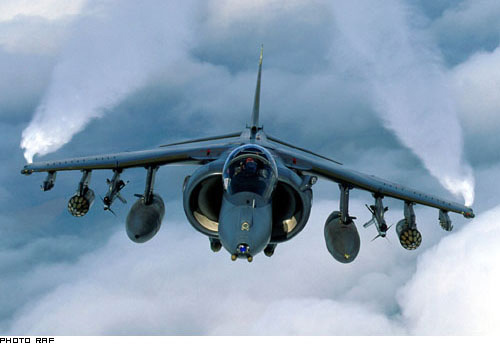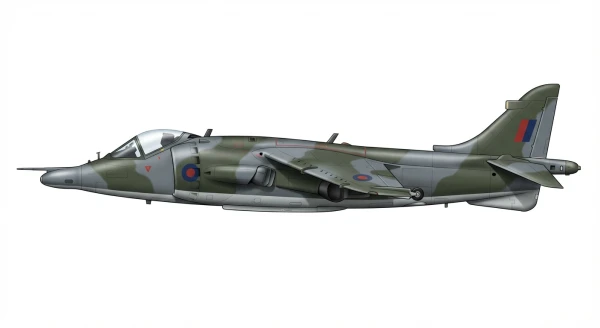Harrier
Summary
| Category | Combat Aircraft |
| Origin country | 🇬🇧 United Kingdom |
| Manufacturer | British Aerospace |
| First flight | 28 December 1968 |
| Year introduced | 1969 |
| Number produced | 380 units |
| Average unit price | $24 million |
Description
Development of a more powerful Harrier successor began in 1973 as a cooperative effort between McDonnell Douglas (MDD) in the US and Hawker Siddeley in the UK, which became British Aerospace in 1977. While first-generation Harriers entered service with the Royal Air Force and United States Marine Corps, operational experience revealed the need for a more capable aircraft. The British government's limited requirements and budget constraints led Hawker to withdraw from the Pegasus 15 engine development project in 1975. With US interest, work proceeded on a less ambitious Harrier, featuring a larger wing and composite materials. Two prototypes flew in 1978, and in 1980, the UK considered modifying the American program to meet their needs, leading to the incorporation of British-designed leading-edge root extensions in the MDD wing design. In 1982, the UK fully joined the US-UK program, committing US$280 million to development costs and the purchase of at least 60 aircraft. British Aerospace (BAe) became a major subcontractor, manufacturing sections like the rear fuselage, and later became the prime contractor for the Harrier II, an Anglicized version of the AV-8B, with McDonnell Douglas as a subcontractor and final assembly at Dunsfold, England. The first BAe-built development GR5 flew on 30 April 1985, entering service in July 1987. The first RAF squadron equipped with the Harrier II was declared operational in December 1989.
The Harrier II is an extensively modified version of the first generation Harrier GR1/GR3 series. The original aluminum alloy fuselage was replaced with one made extensively of composites, providing significant weight reduction and increased payload or range. A new one-piece wing provides around 14 per cent more area and increased thickness. The wing and leading-edge root extensions allows for a 6,700-pound (3,035 kg) payload increase over a 1,000 ft (300 m) takeoff compared with the first generation Harriers. The RAF's Harrier IIs feature an additional missile pylon in front of each wing landing gear, as well as strengthened, stainless steel leading edges on the wings in order to meet higher bird strike requirements. Among the major differences with the American variant, was the new ZEUS Electronic countermeasure (ECM) system. The Harrier II's cockpit has day and night operability and is equipped with head-up display (HUD), two head-down displays known as multi-purpose colour displays (MPCD), a digital moving map, an inertial navigation system (INS), and a hands-on-throttle-and-stick system (HOTAS). Like the British Aerospace Sea Harrier, the Harrier II used an elevated bubble canopy to provide a significantly improved all-round view.
The Harrier GR7's armament consists of two 25 mm ADEN cannon pods under the fuselage for emergency use, along with eight hardpoints capable of carrying up to 8,000 lb (3,650 kg) of payload. These hardpoints accommodate various combinations of ordnance, including LAU-5003 rocket pods, each housing 19 CRV7 70 mm rockets, or Matra rocket pods with 18 SNEB 68 mm rockets each. For air-to-air defense, the aircraft can carry up to four AIM-9 Sidewinder missiles, or six with an adapter. It is also cleared to carry the AGM-65 Maverick air-to-ground missile. Bomb options include Paveway II/III/IV and Enhanced Paveway II/II+ series of laser-guided bombs, and unguided 540 and 1,000 lb bombs, as well as 3 kg and 14 kg practice bombs. Furthermore, the Harrier can carry two auxiliary drop tanks or a reconnaissance pod such as the Digital Joint Reconnaissance Pod (DJRP), Sniper, and TIALD, with the TIALD pod replacing the ADEN guns when mounted.
The British Aerospace Harrier II served with both the Royal Air Force and Royal Navy under the Joint Force Harrier organization and participated in numerous conflicts, making significant contributions in combat theaters such as Kosovo, Iraq, and Afghanistan. Its primary roles encompassed air interdiction and close air support, with secondary duties including power projection and reconnaissance. The Harrier II initially entered service with squadrons based in Royal Air Force Germany, designed to deter Soviet aggression and conduct ground attacks if necessary, emphasizing interdiction operations due to its enhanced range and survivability compared to its predecessor. Although considered too immature for deployment during the 1991 Gulf War, it later patrolled no-fly zones over Iraq starting in 1993. In 1995, it was stationed at Gioia del Colle Air Base in Italy as part of NATO's deterrent force in the aftermath of the collapse of Yugoslavia, carrying out both attack and reconnaissance missions, and seeing modifications to integrate GPS navigation. Notably, the Harrier GR7s saw trials on Invincible-class aircraft carriers in 1994, leading to operational naval deployments beginning in 1997. Budgetary pressures led to the early retirement of all Harrier IIs in December 2010.
Main Variants:
-
GR.5: The GR5 was the RAF's initial version of the second-generation Harrier, distinguished by significant differences from the USMC AV-8B in avionics, armaments, and countermeasures.
-
GR.7: As an upgraded model of the GR5, the GR7 primarily added a night-time operational capability and incorporated various avionics improvements.
-
GR.7A: Some GR7s were equipped with uprated Rolls-Royce Pegasus engines, which provided significantly improved takeoff and landing capabilities, and could carry greater payloads.
-
GR.9: The GR9 was a major upgrade from the GR7 standard, enhancing the Harrier fleet's avionics, communications systems, and weapons capabilities through the Joint Update and Maintenance Programme (JUMP).
-
T.10: The Harrier T10 represents the first two-seat training variant of the Harrier II, based on the USMC Harrier trainer the TAV-8B, but uniquely retaining full combat capabilities.
Technical specifications
| Version: Harrier GR.1 | |
|---|---|
| Crew | 1 pilot |
| Operational range | 1,500 km (932 mi) |
| Maximum speed | 1183 km/h (735 mph) |
| Wing area | 18.7 m² (201.1 sqft) |
| Wingspan | 7.7 m (25.3 ft) |
| Height | 3.5 m (11.3 ft) |
| Length | 13.9 m (45.6 ft) |
| Service ceiling | 14,996 m (49,199 ft) |
| Empty weight | 5,530 kg (12,192 lbs) |
| Max. takeoff weight | 11,500 kg (25,353 lbs) |
| Powerplant | 1 x turbojet Rolls-Royce Pegasus 101 delivering 8618 kgf each |
| Ejection seat | Martin-Baker Mk 9 |
Current operating countries
All operators
Armament
Missiles payload:
- Air-to-Surface AS.37 Martel
- Air-to-Air Short-Range Raytheon AIM-9 Sidewinder


